微尺度换热与流动研究进展陶文铨共63页PPT资料
- 格式:ppt
- 大小:2.01 MB
- 文档页数:63
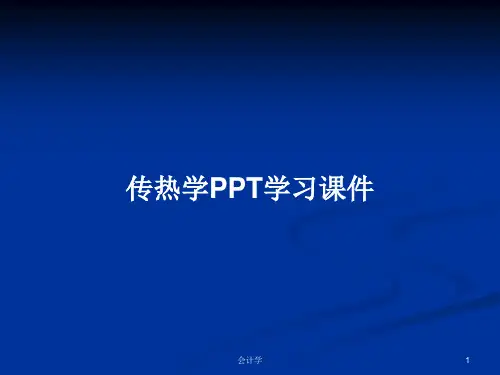
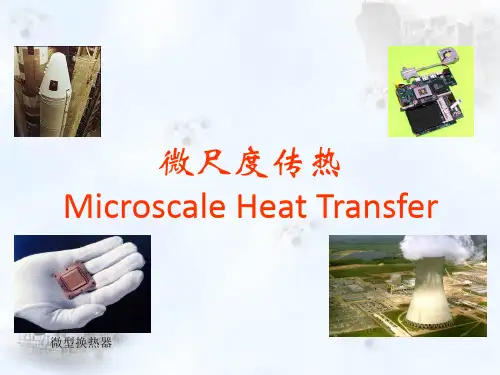
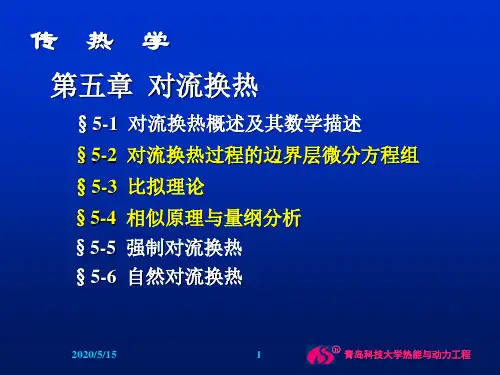
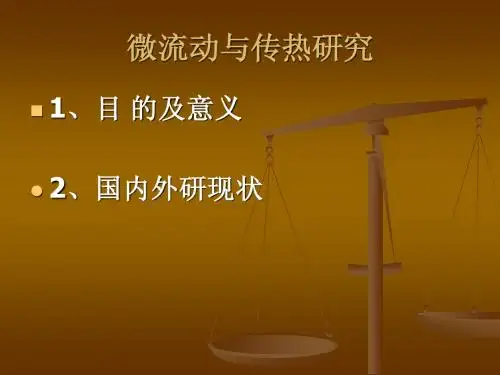


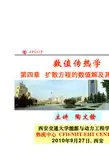
主讲陶文铨西安交通大学能源与动力工程学院热流中心CFD-NHT-EHT CENTER 2010年9月27日, 西安数值传热学第四章扩散方程的数值解及其应用(1)4.1 一维导热问题4.1.1一维稳态导热的通用控制方程4.1.3界面导热系数的确定方法4.1.4 一维非稳态导热控制方程的离散化4.1.2通用控制方程控制容积积分法的离散4.1.5 数学上的稳定未必导致物理上有意义的解一维稳态导热问题不同坐标系通用控制方程0 P P()0P x x Δ=i调和平均已经广泛为国内外学术界所接受。
≤1数学上的稳定未必导致物理上有意义的解无内热源一维非稳态导热,初场均匀,两表面0]T +代入下式:P(全隐格式)才能满足。
结论:数学上的稳定未必导致物理上有意义的解;推=xΔa TP P极坐标均可以表示成为:2.解决通用化的一种方案为写出适合于三种坐标系中系数的通用表达式,特引进两个辅助变量:(1)x –方向标尺因子,scaling factor ,x-方向的距离表示成为sx x δi 。
对直角、圆柱坐标规定1;sx ≡(2)y-方向引入一个名义半径,R 。
对直角坐标R =1,据此,东西导热距离为:sx xδi 东西导热面积为:R /y sxΔ对极坐标取;sx r =对圆柱与极坐标R =r三种二维正交坐标系中离散方程的统一表达式按这种方式编制程序时,只要设置一个变量MODE,4.3 源项与边界条件的处理4.3.1非常数源项的线性化处理1. 线性化方法4.3.2第二、三类边界条件使方程组封闭的处理2. 线性化方法讨论3. 线性化方法应用实例1. 补充以边界节点代数方程的方法2. 附加源项法S= P2. 线性化方法讨论(1)对与被求解变量有关的非常数源项,线性化比假定为常数更合理:用*()PS f T =来表示P 的源项比落后一个迭代步;P C P T S S S =+(2)任何复杂的函数总可以用线性函数来近似逼近;线性又是建立线性代数方程所必须的;(3)是为保证代数方程迭代求解收敛所必须;0P S ≤P P nb nb a a b φφ=+∑P nb a a ≥∑P nb P a a S V =−Δ∑代数方程迭代求解收敛的充分条件是,因为可以确保代数方程迭代求解收敛。
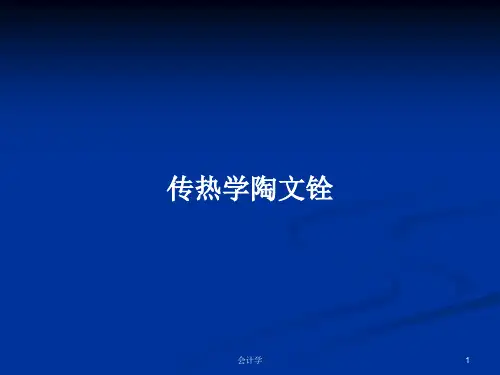

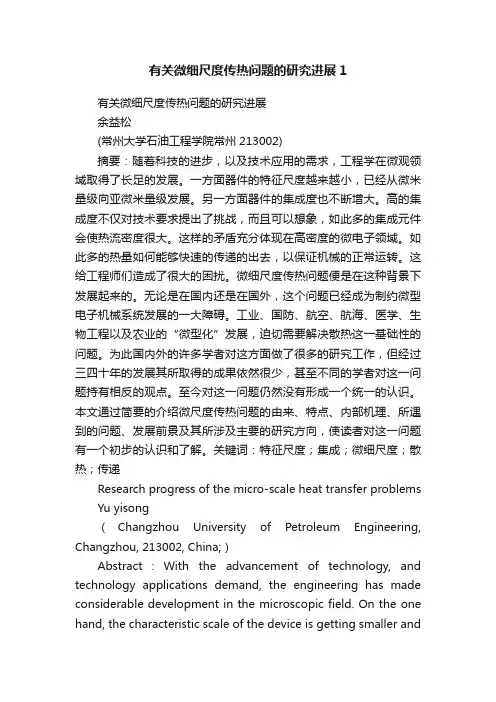
有关微细尺度传热问题的研究进展1有关微细尺度传热问题的研究进展余益松(常州大学石油工程学院常州213002)摘要:随着科技的进步,以及技术应用的需求,工程学在微观领域取得了长足的发展。
一方面器件的特征尺度越来越小,已经从微米量级向亚微米量级发展。
另一方面器件的集成度也不断增大。
高的集成度不仅对技术要求提出了挑战,而且可以想象,如此多的集成元件会使热流密度很大。
这样的矛盾充分体现在高密度的微电子领域。
如此多的热量如何能够快速的传递的出去,以保证机械的正常运转。
这给工程师们造成了很大的困扰。
微细尺度传热问题便是在这种背景下发展起来的。
无论是在国内还是在国外,这个问题已经成为制约微型电子机械系统发展的一大障碍。
工业、国防、航空、航海、医学、生物工程以及农业的“微型化”发展,迫切需要解决散热这一基础性的问题。
为此国内外的许多学者对这方面做了很多的研究工作,但经过三四十年的发展其所取得的成果依然很少,甚至不同的学者对这一问题持有相反的观点。
至今对这一问题仍然没有形成一个统一的认识。
本文通过简要的介绍微尺度传热问题的由来、特点、内部机理、所遇到的问题、发展前景及其所涉及主要的研究方向,使读者对这一问题有一个初步的认识和了解。
关键词:特征尺度;集成;微细尺度;散热;传递Research progress of the micro-scale heat transfer problems Yu yisong(Changzhou University of Petroleum Engineering, Changzhou, 213002, China;)Abstract:With the advancement of technology, and technology applications demand, the engineering has made considerable development in the microscopic field. On the one hand, the characteristic scale of the device is getting smaller andsmaller, from microns to submicron development. The other hand, the device integration is also increasing. The high degree of integration is not only a challenge on the technical requirements, but you can imagine, so many integrated components cause the heat flux. This fully reflects the contradictions in the field of high-density microelectronic. How so much heat can be quickly passed out, in order to ensure the normal operation of the machinery? This caused a lot of distress to the engineers. A micro-scale heat transfer problem is developed in this context. Whether at home or abroad, this issue has become a major obstacle restricting the development of micro-electro-mechanical systems. Industrial, defense, aviation, marine, medical, bio-engineering, and agriculture "miniaturization" development, there is an urgent need to address the basic problem of the heat. This home and abroad many scholars in this area to do a lot of research work is still very small, but after three or four decades the development of their achievements, and even different scholars hold the opposite point of view on this issue. So far on this issue is still not formed a unified understanding. In this paper, a brief introduction to micro scale heat transfer problem the origin, characteristics, internal mechanism, the problems encountered, the prospects for the development its main research direction, so that readers have a preliminary knowledge and understanding of this issue.Keywords:Characteristic scale;Integrated;Fine-scale;Radiating;Transfer1 引言20世纪60年代著名物理学家Richard Feynman[1]提出了微型机械的设想,这开辟了工程学的一个新的领域-微电子机械系统。

微尺度流体液力学与传热特性研究第一章引言流体力学和传热学是物理学的两个分支,它们分别研究流体的运动和与物体之间的热传递。
在微尺度下,流体的流动和传热特性往往与传统尺度下的情况有很大不同,这使得微尺度流体力学和传热学成为了一个热点研究领域。
第二章微尺度流体力学微尺度流体力学研究的主要是微观尺度下的流体行为,主要包括微通道流、微纳米颗粒悬浮体、微纳米流动和微纳米流体特性研究等。
微尺度流体力学与传统流体力学的不同之处在于,微尺度下的流体运动主要受到分子效应和表面效应的影响。
微尺度流体力学研究中的主要问题包括:纳米通道流体的输运机理和性质、纳米尺度的流体相变、微尺度下的流体稳定性和混合、微通道流中的传热过程以及微纳米流动中的流动稳定性等。
第三章微尺度传热学微尺度传热学主要研究微尺度下的传热特性,包括对于微观物质热传递机理的研究以及针对微观传热问题的解决方案。
在微尺度下,分子热传递是十分重要的。
微尺度传热学的主要问题包括:微流混合中的传热增强、纳米流体的相变传热、微观尺度下的液-液传热、界面传热,以及微观传热与微观流体力学的耦合等。
第四章微尺度流体力学与传热特性的重要性微尺度流体力学和传热学的研究对于微纳米器件和系统的设计和制造具有非常重要的意义,因为这些器件和系统的效率往往受到微观尺度下的流体力学和传热特性的影响。
比如,在微纳米元件中,微通道的增强传热和制冷效果是非常重要的。
研究微通道流中传热特性的机理和提高热传递效率是这一领域关注的重点。
此外,还可以应用微纳米流体力学和传热学的知识来设计高效的微纳米传感器和微纳米能量转换器等。
第五章结论微尺度流体力学和传热学的研究领域涉及到多个方面,包括微纳米元件、微纳米系统、生物体系等,发展非常迅速,对于推动微纳米技术的发展具有重要意义。
未来我们可以通过更多的理论和实验研究来深入挖掘微尺度流体力学和传热学的奥秘,进一步开发和设计出更加智能化、有效率的微纳米器件和系统。